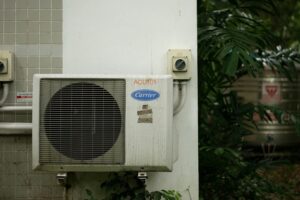Air conditioners require regular maintenance and annual deep cleaning to ensure they’re in good working order, which will improve the comfort level of your home and keep energy costs down.
Routine maintenance is simple: Regularly check, clean and/or replace the filter to remove buildup that causes airflow blockage. Even with routine maintenance, air conditioners will need to be deep cleaned to ensure that the entire unit, including the coils and fins, is in good working order. With the help of experts, we’ve broken down everything you need to know about how to clean and maintain an air conditioner. And, if you’re in the market for a new window unit, check out the website and call us.
How often to clean an air conditioner
“An air conditioner condenser should be deep cleaned once per year,” says Brian Shaunfield, a store manager at Lowe’s. “However, a unit’s air filter should be changed regularly to reduce allergens and allow good airflow.”
Shaunfield recommends changing or cleaning the air filter every one to two months. Some models have filters that need to be cleaned more often than others, so check the owner’s manual for guidance and take the needs of your home into consideration.
After cleaning and/or replacing the filter, it can be helpful to make a calendar entry a month or two down the line to remind you when you next need to perform that task. (Consider, too, making an additional note for cleaning hard-to-reach places.) However, even with reminders, it can be easy to overlook cleaning an air conditioner as regularly as needed. These signs are some signs that your air conditioner is overdue for cleaning:
• The unit isn’t cooling as well as it used to.
• The unit is blowing hot air.
• An unpleasant smell is present.
• There is a buildup of dust and dirt on the filter.
What to avoid when cleaning an air conditioner
While cleaning an air conditioner is a relatively simple task, incorrect cleaning techniques can lead to major damage. “Condenser coils and evaporator coils have fins that can bend easily,” says Yooshin Kim, a senior engineer at LG Electronics. “Avoid touching these areas to avoid damaging the fins.”
When cleaning an outdoor unit, be aware that certain tools should not be used for the job. “Never use a pressure washer to rinse the inside of an air conditioner unit,” Shaunfield says. “A strong force of water can damage air conditioner unit fins, which are very delicate.” Damaged fins can be repaired using a fin tool, or by professionals.
As with all electronic household appliances, care should be taken to dry all components before returning them to the AC unit. “Also, avoid putting a wet filter back into the unit,” Kim says. “Make sure the filter is dried before reinstalling.”
How to deep clean a window unit air conditioner
Step 1: Clean the grille cover
Unplug the air conditioner and open and/or remove the cover from the front of the unit. Using a microfiber cloth, wipe both sides of the grille cover to remove dirt and dust. If needed, spray the cloth with an all-purpose cleaner.
Step 2: Clean the filter
Locate and remove the filter, consulting the user’s manual for instructions on how to do so. To clean it, either use a vacuum fitted with a brush attachment, wipe it with a damp microfiber cloth or use a sink faucet or hose spray attachment to dislodge buildup. Dry the filter thoroughly before returning it to the unit.
Step 3: Vacuum the interior
Use a vacuum fitted with a soft brush attachment to clean the interior of the unit, including the fins on the condenser and evaporator. When vacuuming the fins, take care to work vertically, or top-down, and use a gentle touch to avoid bending or damaging them.
Step 4: Clean the coils
Use an air conditioner coil spray cleaner, following the manufacturer’s usage instructions, to remove buildup from the unit’s coils.
How to deep clean an outdoor unit air conditioner
Step 1: Clean the filter
Check the air filter and replace or clean it if it’s dirty. To clean it, either use a vacuum fitted with a brush attachment, wipe it with a damp microfiber cloth or use a sink faucet or hose spray attachment to dislodge buildup. Dry the filter thoroughly before returning it to the unit.
Step 2: Perform a visual inspection
Check the vent, register and grilles and remove airflow blockages if there are any. Then, visually inspect the lines leading to and from the air conditioner unit; if there is any damage or missing insulation in need of replacing, arrange for service.
Step 3: Clean the unit
Turn off the breaker and remove the top of the air conditioning unit. Remove debris from the bottom of the unit by hand or with a vacuum.
Step 4: Clean the coils
Spray the fins with an air conditioner coil cleaner, following the manufacturer’s instructions. Rinse the coil cleaner using a hose.
Step 5: Rinse, dry and reassemble the unit
Using a hose or a rag, rinse off the outside of the unit. When the filter is dry, replace it, put the top back on the unit and turn the power back on.
This text has been extracted from: https://edition.cnn.com
.






